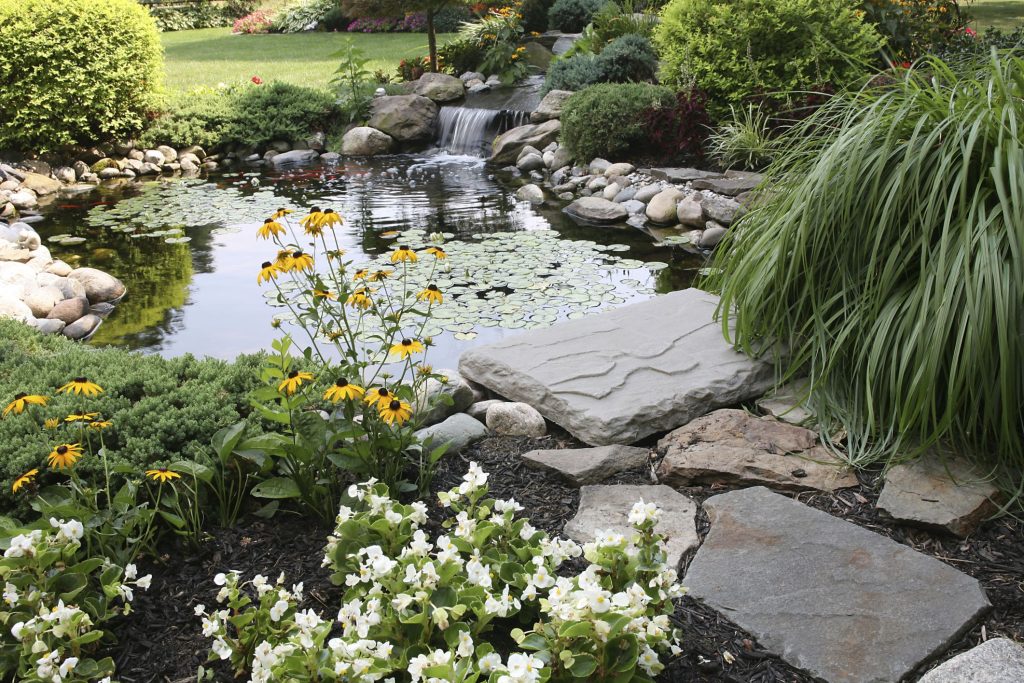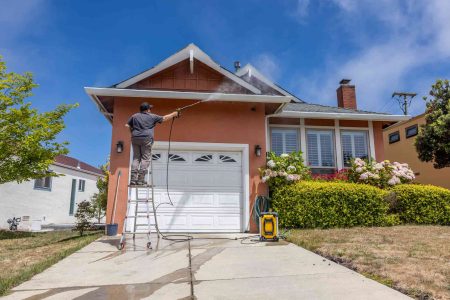A pond is a yard landscaping idea that everyone loves. A water feature always attracts attention, and it quickly becomes the center of social activities. Learn how to make a pond that’s both easy to maintain and a major enhancement for your home.
When to Make a Pond
The best time to build a garden pond is in the summer or early fall to ensure that the ground will be fully drained.
Choose a warm, dry day for installing the pond liner, as sheet liner materials like EPDM and PVC tend to be stiff. The sun will soften the material.
Permits and Codes
Check with your city permit office about permits for building residential garden ponds. Ponds under a certain depth and volume may not require a permit. Installing an outdoor GFCI outlet for a pond pump or filter will require an electrical permit.
Safety Considerations
Call 811 or log onto the Call Before You Dig hotline to be routed to your local utilities marking service. Digging a pond may expose electrical lines, low-voltage landscape lighting wires, gas lines, water supply pipes, and other vital services.
What You’ll Need
Equipment / Tools
- Shovel
- Flat shovel
- Garden hose
- Tape measure
- Bubble level
Materials
- Pond liner
- Pond underlayment
- Decorative stones
- Pond pump (optional)
Instructions
How to Make a Pond
-
Create the Shape of the Pond
Lay a garden hose on the ground to create the general shape of the pond. Step back and view the pond from all angles. Adjust as needed.
-
Excavate the Dirt
Dig the pond perimeter by following the inside of the garden hose shape. Use the flat shovel to dig. Remove the hose. Switch to the regular shovel and continue digging until you reach the desired depth, usually 18 to 36 inches.
-
Sculpt the Pond Shape
Sculpt the inside of the hole to the intended pond shape. Aim for smooth slopes and curves. Terrace upward for tall walls, each step about five to seven inches high.
-
Add the Liner Underlayment
Start at the bottom of the pond and open up the liner underlayment. The underlayment should fit the pond’s contours and extend another foot or two past the rim.
What Is Pond Underlayment?
Underlayment is a soft, thin fabric installed under the pond liner to protect it from rocks and other hazards that could damage it.
-
Add the Pond Liner
Place the rolled or folded pond liner in the excavated hole at its lowest point. Open up the liner and contour it to the shape of the pond, Roll or unfold the liner upward until it reaches the pond bank.
-
Add Decorative Stonework
Spread small, smooth stones on the bottom of the pond. Add flat stones like flagstones on the rim to cover up the pond liner.
-
Add the Pond Pump (Optional)
If you’ll also be adding a water feature like an outdoor waterfall, place the submersible pond pump at pond’s lowest point. Run the electrical cord up the side of the pond. Plug it into a GFCI outlet.
-
Fill the Pond
With a good garden hose, fill the pond with water. Stop filling at two to three inches from the rim of the pond.
Tips for Making a Pond
- Cover as much pond liner as possible with stonework or aquatic plants since UV rays break down liner materials.
- Check on local water costs and restrictions before deciding on the pond size.
- Create an optional drain at the bottom of the pond if you anticipate draining the pond often. Otherwise, use a submersible pump.
- For pond liners, HDPE is rigid and difficult to lay, but it is the cheapest, at around $50 per 100 square feet.
When to Call a Professional
Call a contractor to relieve yourself of the considerable work involved with digging the pond hole. Workers using even a mini- or small-size excavator can quickly dig the hole in hours—a job that can take days or weeks by hand.
-
What is the cheapest way to make a pond?
A cheap, budget-friendly way to make a pond is to build it without a traditional liner. Plain, clumping cat litter, which develops into a thick clay upon contact with water, can be applied to the sides and the bottom of the pond. A similar but better option is granular bentonite clay, specifically for pond sealing, costing around $70 to $80 for 25 pounds.
-
How deep does a pond have to be?
Garden ponds tend to be from 18 inches to 36 inches deep. Fish and other wildlife dependent on the pond may require greater depths. Shallow ponds experience temperature spikes, which can cause excessive algae growth. Deeper ponds have less of a problem with algae but are more challenging to build and require more water.
-
Can you make a pond without a liner?
You can make a pond without a liner, though the hole must be lined with some substance to limit water loss. Bentonite clay is one form of pond lining material that is sometimes used to replace EPDM, PVC, or other polymer-based pond liners. The granular bentonite swells with water contact and becomes a thick, clay-like substance to limit, but not entirely prevent, water loss.
Read the full article here














